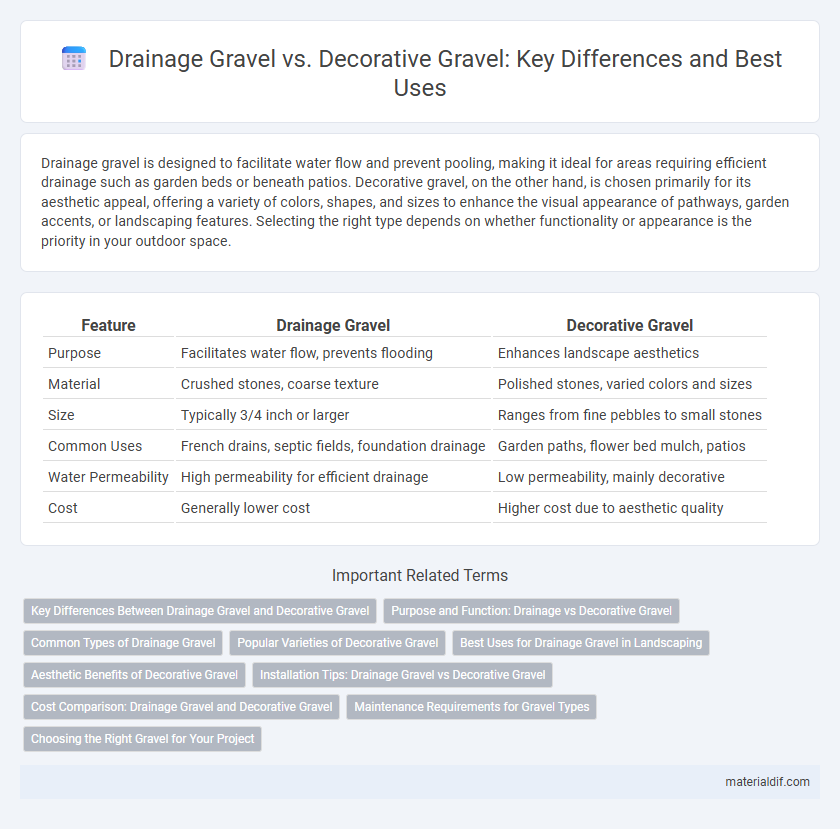Drainage gravel is designed to facilitate water flow and prevent pooling, making it ideal for areas requiring efficient drainage such as garden beds or beneath patios. Decorative gravel, on the other hand, is chosen primarily for its aesthetic appeal, offering a variety of colors, shapes, and sizes to enhance the visual appearance of pathways, garden accents, or landscaping features. Selecting the right type depends on whether functionality or appearance is the priority in your outdoor space.
Table of Comparison
| Feature | Drainage Gravel | Decorative Gravel |
|---|---|---|
| Purpose | Facilitates water flow, prevents flooding | Enhances landscape aesthetics |
| Material | Crushed stones, coarse texture | Polished stones, varied colors and sizes |
| Size | Typically 3/4 inch or larger | Ranges from fine pebbles to small stones |
| Common Uses | French drains, septic fields, foundation drainage | Garden paths, flower bed mulch, patios |
| Water Permeability | High permeability for efficient drainage | Low permeability, mainly decorative |
| Cost | Generally lower cost | Higher cost due to aesthetic quality |
Key Differences Between Drainage Gravel and Decorative Gravel
Drainage gravel is specifically designed with angular, coarse particles to facilitate water flow and prevent soil erosion, making it ideal for foundations, drainage systems, and French drains. Decorative gravel, in contrast, typically consists of smoother, rounded stones available in various colors and sizes, enhancing aesthetic appeal in landscaping, garden paths, and patios. Key differences include particle shape, function, and typical usage, with drainage gravel prioritizing permeability and structural support, while decorative gravel focuses on visual enhancement and surface coverage.
Purpose and Function: Drainage vs Decorative Gravel
Drainage gravel is engineered to facilitate water flow and prevent soil erosion by providing excellent permeability, making it ideal for foundation drainage, French drains, and landscaping projects requiring moisture control. Decorative gravel emphasizes aesthetics, featuring a variety of colors, shapes, and sizes to enhance garden paths, patios, and outdoor spaces without focusing on water management. The key distinction lies in drainage gravel's functional role in water management versus decorative gravel's primary purpose of visual appeal in landscaping.
Common Types of Drainage Gravel
Common types of drainage gravel include pea gravel, crushed stone, and river rock, each offering excellent water flow and stability. Pea gravel consists of small, rounded stones that prevent soil erosion while facilitating efficient drainage. Crushed stone, typically made from limestone or granite, provides angular edges that lock together, ensuring superior drainage and structural support.
Popular Varieties of Decorative Gravel
Popular varieties of decorative gravel include pea gravel, river rock, and colored crushed stone, each known for enhancing landscape aesthetics with distinct textures and hues. Pea gravel offers smooth, rounded stones typically in shades of gray, brown, and tan, popular for pathways and patios. River rock provides larger, polished stones that add natural beauty, while colored crushed stone introduces vibrant tones to garden beds and borders.
Best Uses for Drainage Gravel in Landscaping
Drainage gravel, composed of angular, coarse aggregates like crushed stone or pea gravel, excels in improving water flow and preventing soil erosion in landscaping projects. Its best uses include base layers for retaining walls, French drains, and around foundation footings to channel water away efficiently. Unlike decorative gravel, which is mainly aesthetic with smoother, uniform stones, drainage gravel prioritizes functionality by enhancing soil permeability and reducing water buildup.
Aesthetic Benefits of Decorative Gravel
Decorative gravel enhances landscapes with diverse colors, shapes, and sizes, creating visually appealing garden paths and accent areas that elevate curb appeal. Its ability to complement plants and outdoor features adds texture and contrast, making spaces more inviting and stylish. Unlike drainage gravel, decorative gravel focuses on aesthetic value while still providing functional ground cover.
Installation Tips: Drainage Gravel vs Decorative Gravel
Drainage gravel requires proper grading and layering with landscape fabric to ensure effective water flow and prevent clogging, making trench depth and rock size critical for installation. Decorative gravel installation focuses on surface aesthetics and may involve a weed barrier and edging to maintain clean borders while selecting uniform, colorful stones to enhance visual appeal. Both types benefit from compacted subbases, but attention to purpose-specific drainage or appearance guidelines optimizes their performance and longevity.
Cost Comparison: Drainage Gravel and Decorative Gravel
Drainage gravel typically costs between $30 and $50 per ton, offering efficient water flow management ideal for construction and landscaping projects. Decorative gravel, priced from $40 to $100 per ton, provides aesthetic appeal with a variety of colors and textures suitable for garden paths and landscaping features. The cost difference reflects the functional benefits of drainage gravel versus the visual enhancement of decorative gravel.
Maintenance Requirements for Gravel Types
Drainage gravel requires minimal maintenance since its primary function is to facilitate water flow and prevent pooling, often needing occasional clearing of debris to maintain permeability. Decorative gravel demands more upkeep to preserve its appearance, including periodic raking, weed control, and replenishment to prevent displacement and fading. Both types benefit from proper installation techniques to reduce maintenance frequency and ensure long-term effectiveness.
Choosing the Right Gravel for Your Project
Drainage gravel, composed of coarse, angular stones, is specifically designed to facilitate water flow and prevent soil erosion, making it ideal for projects requiring efficient drainage solutions. Decorative gravel, available in various colors and smooth textures, enhances aesthetic appeal for landscaping and garden pathways without prioritizing drainage functionality. Selecting the right gravel depends on project goals, with drainage gravel suited for structural and water management purposes, while decorative gravel serves visual enhancement.
Drainage gravel vs Decorative gravel Infographic

 materialdif.com
materialdif.com